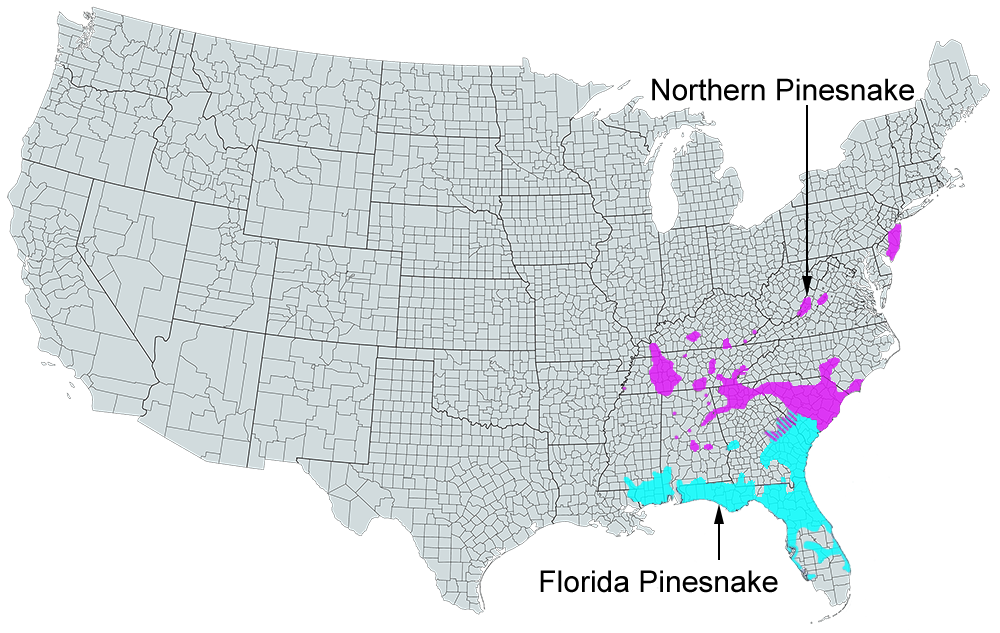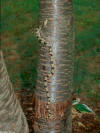Eastern Pinesnake
Pituophis melanoleucus
** Harmless **
Common Name: |
Eastern Pinesnake |
Scientific Name: |
Pituophis melanoleucus |
Etymology: |
|
Genus: |
Pituophis is derived from the Greek words pitys which means "pine" and ophios meaning "serpent". |
Species: |
melanoleucus is derived from the Greek words melanos which means "black" and leukos meaning "white". |
Vernacular Names: |
Bull snake, black and white snake, carpet snake, chicken snake, horned snake. |
Average Length: |
48 - 66 in. (122 - 168 cm) |
Virginia Record Length: |
66.1 in. (167.8 cm) |
Record length: |
83 in. (210.8 cm) |
Systematics: Described originally as Coluber melanoleucus by Francois Marie Daudin in 1803, based on specimens from Florida and South Carolina. Schmidt (1953) restricted the type locality to Charleston, South Carolina. Holbrook (1842) was the first to place this species in the genus Pituophis. All authors in the Virginia literature have used the current nomenclature. The eastern pinesnake group consists of P. m. lodingi, P. m. melanoleucus, P. m. mugitus and P. ruthveni. Only the Northern Pinesnake (P. m. melanoleucus) occurs in Virginia.
Description: A large, stout-bodied snake reaching a maximum total length of 2,108 mm (83.0 inches) (Conant and Collins, 1991). In Virginia, maximum known snout-vent length (SVL) is 1,495 mm (58.9 inches) and maximum total length is 1,678 mm (66.1 inches). Tail length/total length in the Virginia sample was 10.9-11.4% (n = 2).
Scutellation: Ventrals 217-224 (ave. = 220.8 ± 3.3, n = 4); subcaudals 48-53 (ave. = 50.7 ± 2.5, n = 3); ventrals + subcaudals 267-274 (270.3 ± 3.5, n = 3); dorsal scales keeled; scale rows 27-29 at midbody; anal plate entire; infralabials 10/10, 12/12, or 12/13; supralabials 8/8 or 8/7; loreal scale present; preoculars 1/1; postoculars 2/2, 2/3, 3/3, or 3/4; temporal scales 3+4/3+4, 4+6/4+4, or 4+5/2+3; rostral scale elongated and partially separates nasal scales; 4 prefrontal scales present.
Coloration and Pattern: Dorsal body color cream, white, or yellow, with a series of irregular black blotches that become more distinct posteriorly; anterior blotches more diffuse, with considerable melanism in spaces between them; black lateral blotches alternate with dorsal blotches, except on tail; blotches usually black anteriorly, but may be brown posteriorly; white or yellow body scales usually edged in black; venter of body and tail cream, white, or yellow and patternless; head cream to white with irregular pattern of black spots on dorsum; black crossbar connecting eyes may be present; labial scales and chin white; supralabials may be partially edged in black. This is a large, robust snake with a somewhat elongated snout.
Sexual Dimorphism: Sexual dimorphism cannot be described for Virginia P. melanoleucus due to the lack of specimens. Ernst and Barbour (1989b) reported tail length/total lengths of 11-14% in males and 10-12% in females.
Juveniles: Juveniles are patterned as adults but have black on a white body. No data are available on hatchlings from Virginia. Hatchlings in New Jersey were 337-526 mm total length (ave. = 416) and weighed 23.2-41.4 g (ave. = 32.4) (Zappalorti et al., 1983).
Confusing Species: Eastern Pinesnakes may be confused with Eastern Hog-Nosed Snakes (Heterodon platirhinos), which also hiss. Eastern Hog-Nosed Snakes are usually multicolored with orange, red, black, and yellow, have a sharply upturned snout, and are smaller.
Geographic Variation: The lack of specimens precludes an analysis of geographic variation in Virginia.
Biology: Eastern Pinesnakes are secretive, burrowing snakes and are seldom seen, even by long-term residents in areas known to contain them. Dunn (1917) noted that the habitat in which he found the first one in Virginia had mountain laurel and rhododendron on steep slopes. The meager information from various people who have seen them in Virginia suggests the habitat is dry, open, and on mountain slopes, ridges, or hills, sometimes with abundant rock cover. The substrate is usually sandy or of such a texture as to allow burrow construction. Vegetation may be sparse and limited to pine and blueberry (Rubus). In the New Jersey Pine Barrens, P. melanoleucus has been most often found in mixed pine and oak habitat and in human-disturbed areas (Zappalorti and Burger, 1985; Burger and Zappalorti, 1988). The activity season in New Jersey is April-October (Zappalorti et al., 1983). The activity season is unknown in Virginia; all known observation dates are May-August, Pituophis melanoleucus overwinters in underground hibernacula and constructs shallow, underground summer dens (Burger et al., 1988).
Eastern Pinesnakes are predators of small rodents, birds, and birds' eggs (Wright and Wright, 1957; Zappalorti et al., 1983). Brown (1979) reported a North Carolina specimen that ate four bob-white quail (Colinus virginianus) eggs. Juveniles may eat lizards (Conant and Collins, 1991). Known predators of adults and juveniles in New Jersey are red foxes (Vulpes vulpes), striped skunks (Mephitis mephitis), northern short-tailed shrews (Blarina brevicauda), and humans; Northern Scarlet Snakes (Cemophora coccinea) eat the contents of eggs (Burger et al., 1992). Nothing is known about predators and prey of this snake in Virginia.
Pituophis melanoleucus is oviparous and lays 3-27 eggs per clutch (Wright and Wright, 1957). Except as noted, the following is from Zappalorti et al. (1983) and Burger and Zappalorti (1986,1991). Mating occurred in May. Females laid 4-16 eggs (ave. = 9.5 ± 2.0) 17 June-14 July in side chambers of long burrows that females excavated in sandy soil; some of these were used for several years. Snakes used their heads to loosen the soil, push it back, and penetrate deeper; body coils and the tail were used to shift sand backwards. Nest burrows were in large clearings with less than 10% tree cover. Eggs measured 46.3-78.6 x 21.7- 44.7 mm and weighed 20.3-74.4 g. Laboratory incubation time was 51-75 days. Comparatively, one road-killed female from Virginia contained nine oviductal eggs when found on 9 July 1989. The eggs averaged 59.3 ± 2.3 x 34.0 ± 2.0 mm in size (length 58-62, width 32-36, n = 3) and 30.5 ± 1.8 g body mass (27.5-32.2, n = 5). Another female from an unknown location in Virginia laid five eggs in captivity (R. G. Glasgow, pers. comm.).
If caught, Eastern Pinesnakes inflate their lungs and quickly expel air across a flap of tissue on the glottis, causing a loud hiss. This usually startles predators; the accompanying tail vibration and striking may help prevent predation. Humans are apt to kill the snake, however.
Remarks: Other common names in the Virginia literature are bull snake (Dunn, 1918, 1936), black-and-white snake (Linzey and Clifford, 1981), and white snake.
Pituophis melanoleucus is seldom seen, despite its large size. This may be due to its rarity, as well as to its secretive nature. All Virginia sightings and observations on its biology should be reported and all road-killed specimens salvaged.
Conservation and Management: This species is listed as status undetermined (Mitchell, 1991a). The U.S. Fish and Wildlife Service lists P. melanoleucus as a Category 2 species in Virginia (Department of the Interior, 1991). It should be obvious from the dearth of information available on this snake that we cannot determine whether this is a rare species that needs protection or if it is simply rarely encountered. A viable population needs to be located and studied before a long-term management plan can be developed.
References for Life History
Photos:
*Click on a thumbnail for a larger version.
Verified County/City Occurrence in Virginia
Augusta
Bath
Botetourt
Craig
CITIES
Verified in 4 counties and 0 cities.
U.S. Range

US range map based on work done by The Center for North American Herpetology (cnah.org) and Travis W. Taggart.



